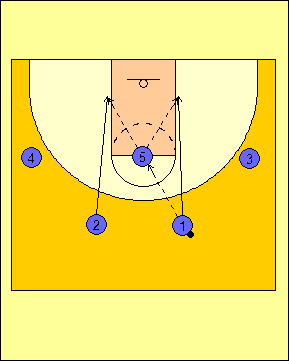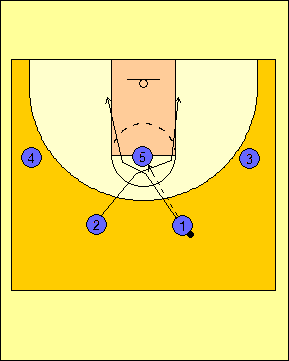
Basketball Coaching DVD's at Championship Productions
HIGH POST OFFENSETeams such as UCLA, Princeton, Georgetown, Louisville,
and others have had great success attacking defenses with the high post
offense. This offense is noted for its versatility and its ability
to take advantage of five players who can share the basketball and pass
it effectively.
Advantages of the High Post Offense
Because the offense is run off of the baseline, it draws the defense from the
baseline. This opens up the area below the free throw line-extended for
backdoors and post-ups. Because of the 2-3 set-up of the high post offense
with the forwards at the wings and the center in the high post, the defense can
be put into situations where they have to make decisions as to how they intend
to guard the offense.
If the defense decides to guard the offense between the man and the basket, the
perimeter jump shot becomes a real possibility. Meanwhile, if the defense
tries to pressure the offense, backdoor lay-ups open up for the offense.
Dead fronts of the high post can also lead to problems in that the lob pass
becomes a possibility to where the center can score easily at the basket.
Second, the offense is versatile when it comes to tempo. Depending on how
the offense plays the defense, it can be a quick-hitting offense or it can run
copious amounts of time off of the clock. If the shots come quickly in the
offense, we would prefer that it be the result of a defensive breakdown like
that of what would be found running any other offense.
Finally, the offense also lends itself to other offenses and offensive
alignments. When the offense breaks down, there are a number of offenses
that the high post offense naturally flows into including motion, the Flex, and
even the pick-and-roll offense. Also, the offense lends itself to
five-out, 2-3 high, and 2-2-1 alignments that can be used to attack the defense.
Disadvantages of the High Post Offense
One of the problems with the offense is that it requires a center who is an
outstanding passer who can play away from the basket. The center must be
able to play at least 15 feet from the basket and will be used as a passer a
great deal of the time. If you cannot trust your center to handle the
basketball and be a threat to score away from the basket, running this offense
will not benefit your team.
The other problem is that since the offense has four perimeter players in it, it
requires that all four perimeter players must be capable of shooting from the
perimeter. Because the offense is perimeter oriented in nature, the
players on the perimeter must be capable of scoring from the perimeter.
Guard-to-Post Pass
The first option in the high post offense is to get the
ball to the high post. When this is done, the passer will initiate
the action that will follow. The passing guard can dive to the low
block on his side which will prompt the opposite guard to dive to the
opposite low block (Diagram 1). The look for the center is to hit
either one for a backdoor lay-up.
The other possibility is to run a post split with a
handoff to either guard (Diagram 2). If the guard gets the ball,
we want him to score. If not, we will run from a three-around-two
alignment which will be described in greater detail later on in the
article.

Diagram
1 |

Diagram
2 |
Guard-to-Forward Pass
When the guard makes a pass to the forward, the offense can go one of two ways:
First, the passing guard can make a UCLA cut to the direction of the pass with
the other guard receiving a back screen from the center on a Hawk cut (Diagram
3).
Second, the passing guard can make a UCLA cut away from the pass and
the other guard uses the back screen from the center to make a Hawk cut
(Diagram 4).

© 2010-2017 Alan Peel Enterprises